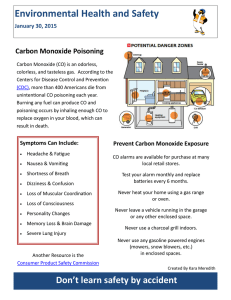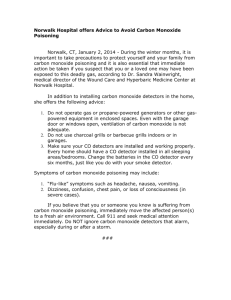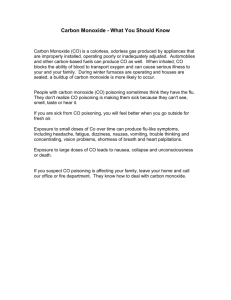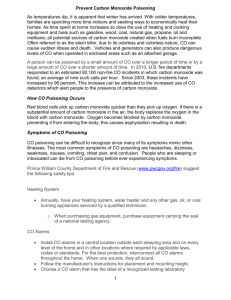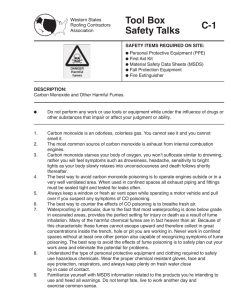Carbon Monoxide: A Fact Sheet by NFPA
advertisement
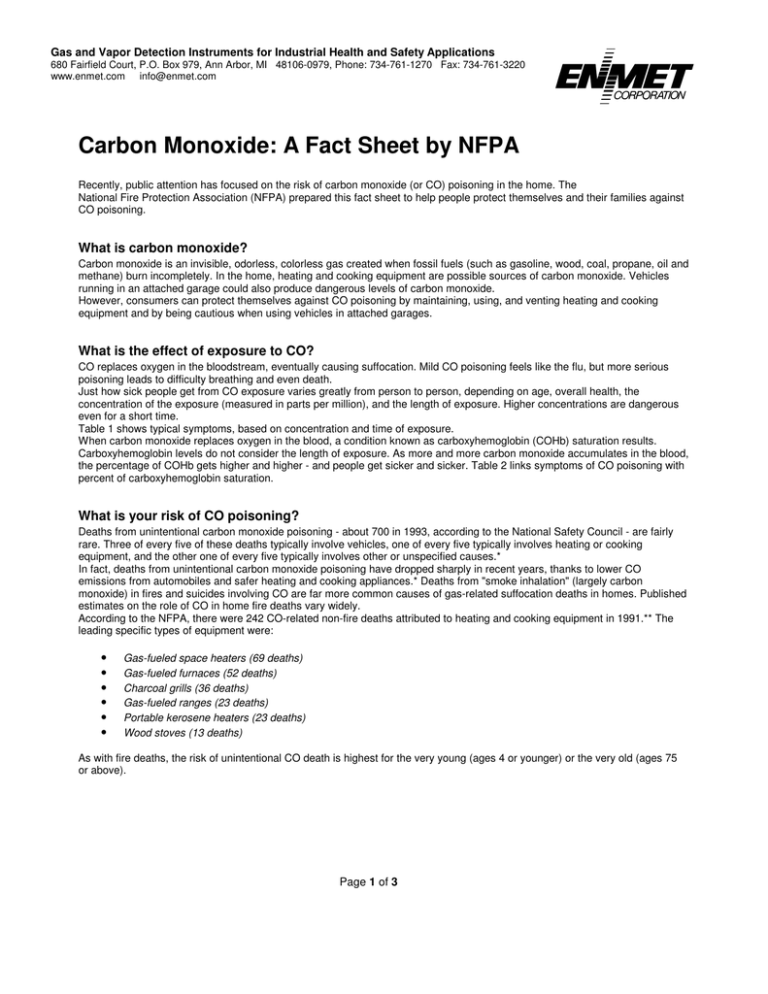
Gas and Vapor Detection Instruments for Industrial Health and Safety Applications 680 Fairfield Court, P.O. Box 979, Ann Arbor, MI 48106-0979, Phone: 734-761-1270 Fax: 734-761-3220 www.enmet.com info@enmet.com Carbon Monoxide: A Fact Sheet by NFPA Recently, public attention has focused on the risk of carbon monoxide (or CO) poisoning in the home. The National Fire Protection Association (NFPA) prepared this fact sheet to help people protect themselves and their families against CO poisoning. What is carbon monoxide? Carbon monoxide is an invisible, odorless, colorless gas created when fossil fuels (such as gasoline, wood, coal, propane, oil and methane) burn incompletely. In the home, heating and cooking equipment are possible sources of carbon monoxide. Vehicles running in an attached garage could also produce dangerous levels of carbon monoxide. However, consumers can protect themselves against CO poisoning by maintaining, using, and venting heating and cooking equipment and by being cautious when using vehicles in attached garages. What is the effect of exposure to CO? CO replaces oxygen in the bloodstream, eventually causing suffocation. Mild CO poisoning feels like the flu, but more serious poisoning leads to difficulty breathing and even death. Just how sick people get from CO exposure varies greatly from person to person, depending on age, overall health, the concentration of the exposure (measured in parts per million), and the length of exposure. Higher concentrations are dangerous even for a short time. Table 1 shows typical symptoms, based on concentration and time of exposure. When carbon monoxide replaces oxygen in the blood, a condition known as carboxyhemoglobin (COHb) saturation results. Carboxyhemoglobin levels do not consider the length of exposure. As more and more carbon monoxide accumulates in the blood, the percentage of COHb gets higher and higher - and people get sicker and sicker. Table 2 links symptoms of CO poisoning with percent of carboxyhemoglobin saturation. What is your risk of CO poisoning? Deaths from unintentional carbon monoxide poisoning - about 700 in 1993, according to the National Safety Council - are fairly rare. Three of every five of these deaths typically involve vehicles, one of every five typically involves heating or cooking equipment, and the other one of every five typically involves other or unspecified causes.* In fact, deaths from unintentional carbon monoxide poisoning have dropped sharply in recent years, thanks to lower CO emissions from automobiles and safer heating and cooking appliances.* Deaths from "smoke inhalation" (largely carbon monoxide) in fires and suicides involving CO are far more common causes of gas-related suffocation deaths in homes. Published estimates on the role of CO in home fire deaths vary widely. According to the NFPA, there were 242 CO-related non-fire deaths attributed to heating and cooking equipment in 1991.** The leading specific types of equipment were: • • • • • • Gas-fueled space heaters (69 deaths) Gas-fueled furnaces (52 deaths) Charcoal grills (36 deaths) Gas-fueled ranges (23 deaths) Portable kerosene heaters (23 deaths) Wood stoves (13 deaths) As with fire deaths, the risk of unintentional CO death is highest for the very young (ages 4 or younger) or the very old (ages 75 or above). Page 1 of 3 How can you protect yourself from CO poisoning? The best defenses against CO poisoning are safe use of vehicles (particularly in attached garages) and proper installation, use and maintenance of household cooking and heating equipment. You may also want to install CO detectors inside your home to provide early warning of accumulating carbon monoxide. However, a CO detector is no substitute for safe use and maintenance of heating and cooking equipment. Safety Tips: • If you need to warm up a vehicle, remove it from the garage immediately after starting the ignition. Do not run a vehicle or other fueled engine or motor indoors, even if garage doors are open. CO from a running vehicle inside an attached garage can get inside the house, even with the garage door open. Normal circulation does not provide enough fresh air to reliably prevent dangerous accumulations inside. • • • • • • • • • Have your vehicle inspected for exhaust leaks, if you have any symptoms of CO poisoning. Have fuel-burning household heating equipment (fireplaces, furnaces, water heaters, wood stoves, and space or portable heaters) checked every year before cold weather sets in. All chimneys and chimney connectors should be evaluated for proper installation, cracks, blockages or leaks. Make needed repairs before using the equipment. Before enclosing central heating equipment in a smaller room, check with your fuel supplier to ensure that air for proper combustion is provided. When using a fireplace, open the flue for adequate ventilation. Kerosene heaters are illegal in many states. Always check with local authorities before buying or using one. Open a window slightly whenever using a kerosene heater. Refuel outside, after the device has cooled. Always use barbecue grills - which can produce carbon monoxide - outside. Never use them in the home or garage. When purchasing new heating and cooking equipment, select factory-built products approved by an independent testing laboratory. Do not accept damaged equipment. Hire a qualified technician (usually employed by the local oil or gas company) to install the equipment. Ask about - and insist that the technician follow - applicable fire safety and local building codes. If you purchase an existing home, have a qualified technician evaluate the integrity of the heating and cooking systems, as well as the sealed spaces between the garage and house. When camping, remember to use battery-powered heaters and flashlights in tents, trailers and motorhomes. Using fossil fuels inside these structures is extremely dangerous. NFPA 501, Standard on Recreational Vehicles, requires the installation of CO detectors in recreational vehicles. What are CO detectors? Household carbon monoxide detectors measure how much CO has accumulated. Currently, CO detectors sound an alarm when the concentration of CO in the air corresponds to 10% carboxyhemoglobin level in the blood. Since 10% COHb is at the very low end of CO poisoning, the alarm may sound before people feel particularly sick. What causes CO detector nuisance alarms? Pollution and atmospheric conditions in some areas cause low levels of CO to be present for long periods of time. In fact, these "background" conditions may increase the COHb level to over 10%, causing CO detectors to alarm even though conditions inside the home are not truly hazardous. • Treat all CO detector alarms as real, until it has been verified that there is no threat from equipment inside the dwelling. If you buy CO detectors: • • • • • • Select detector(s) listed by a qualified, independent testing laboratory. Follow manufacturer's recommendations for placement in your home. Call your local fire department non-emergency telephone number. Tell the operator that you have purchased a CO detector and ask what number to call if the CO detector alarms. Be sure you understand whom to call if your detector alarms, and clearly post that number by your telephone(s). Make sure everyone in the household knows the difference between the fire emergency and the CO emergency numbers (if there is a difference). Test CO detectors at least once a month, following the manufacturer's instructions. Replace CO detectors according to the manufacturer's instructions, usually about every two years. Battery-powered CO detectors may have unique battery packs designed to last approximately two years, compared to batteries used in smoke detectors, which require yearly replacement. Page 2 of 3 What to do if your CO detector alarms: If anyone shows signs of CO poisoning: Have everyone leave the building right away. Leave doors open as you go. • • Use a neighbor's telephone to report the CO alarm, following the instructions you received from the fire department when you bought the detector. Get immediate medical attention. If no one has symptoms of CO poisoning: Open windows and doors, shut down heating and cooking equipment, and call a qualified technician to inspect all equipment. • • Be on the lookout for any symptoms of CO poisoning. Follow the steps above if symptoms appear. Safety Checklist • • • • Carbon monoxide detectors are not substitutes for smoke detectors. Smoke detectors react to fire by-products, before CO detectors would alarm. Smoke detectors give earlier warning of a fire, providing more time to escape. To guard against smoke and fire, be sure that your home has working smoke detectors on every level and just outside of all sleeping areas. Know the difference between the sound of the smoke detectors and the sound of the carbon monoxide detector. Have a home evacuation plan for any home emergency and practice the plan with all members of the household. About the National Fire Protection Association and CO detectors. The National Fire Protection Association (NFPA) prepared this fact sheet as a guide for consumers who are concerned about possible carbon monoxide poisoning at home. At this time, NFPA does not have a standard requiring the installation of household CO detectors. NFPA is currently developing NFPA 720 (proposed). This document is in the NFPA standards cycle and may be published as early as September 1997. The National Fire Protection Research Foundation has initiated a research project to provide NFPA's technical committees with CO detector documentation. * N. Cobb and R.A. Etzel, "Unintentional carbon monoxide-related deaths in the United States, 1979 through 1988, "Journal of the American Medical Association, Volume 266, #5, 1991, pp. 659-693, as reported in National Safety Council's Accident Facts. ** The latest year for which statistics are available at this level of detail. Reprinted with permission from Fire News (Issue 809), Copyright 1995, National Fire Protection Association, Quincy, MA 02269 TABLE 1 Concentration (parts per million) Symptoms 35 No adverse effects within 8 hours. 200 Mild headache after 2-3 hours of exposure. 400 Headache and nausea after 1-2 hours. 800 Headache, nausea and dizziness after 45 minutes; collapse after 2 hours. 1000 Loss of consciousness after 1 hour. 1600 Headache, nausea and dizziness after 20 minutes; unconsciousness after 30 minutes. 3200 Headache, nausea and dizziness after 5-10 minutes; unconsciousness after 30 minutes. 12,800 Immediate physiological effects; unconsciousness and danger of death after 1-3 minutes. Source: U.S. Consumer Product Safety Commission Table 2 Effects of Carboxyhemoglobin (COHb) Saturation COHb Saturation (%) Symptoms 0-10 None. 10-20 Tension in forehead, dilation of skin vessels. 20-30 Headache and pulsating temples. 30-40 Severe headache, weariness, dizziness, weakened sight, nausea, vomiting, prostration. 40-50 Severe headache, plus increased breathing and pulse rates, asphyxiation and prostration. 50-60 Same as above, plus coma, convulsions, Cheyne-Stokes respiration. 60-70 Coma, convulsions, weak respiration and pulse. Death is possible. 70-80 Slowing and stopping of breathing, death within hours. 80-90 Death in less than 1 hour. 90-100 Death within a few minutes. Page 3 of 3
